AVGARD NEO Pumped Hydroelectric Energy Storage Design Brief
VerifiedAdded on 2022/09/22
|10
|2804
|21
Report
AI Summary
This report presents a comprehensive design brief for a pumped hydroelectric energy storage system, focusing on a project in the Wollongong region of NSW. The brief outlines the core technology, which involves storing energy in the form of water in an elevated reservoir, utilizing cheaper electricity from the grid to pump water uphill. The report details the key technologies, including conventional pumped hydro and variable speed turbine systems, alongside relevant engineering principles like Bernoulli's principle and Newton's laws of motion. It includes background research on the location and topography of the Illawarra escarpment, considering the client's needs and goals, which involve reclaiming land, utilizing regional resources, and pursuing entrepreneurial aspirations related to renewable energy. The report also examines precedents, such as existing pumped storage stations, and outlines initial ideas for modeling the system. It discusses the project stakeholders, requirements, and variables, including dependent and independent variables, along with their relationships. The design brief emphasizes factors like head, flow rate, waterway design, and reservoir construction, providing a detailed overview of the project's technical and strategic considerations.
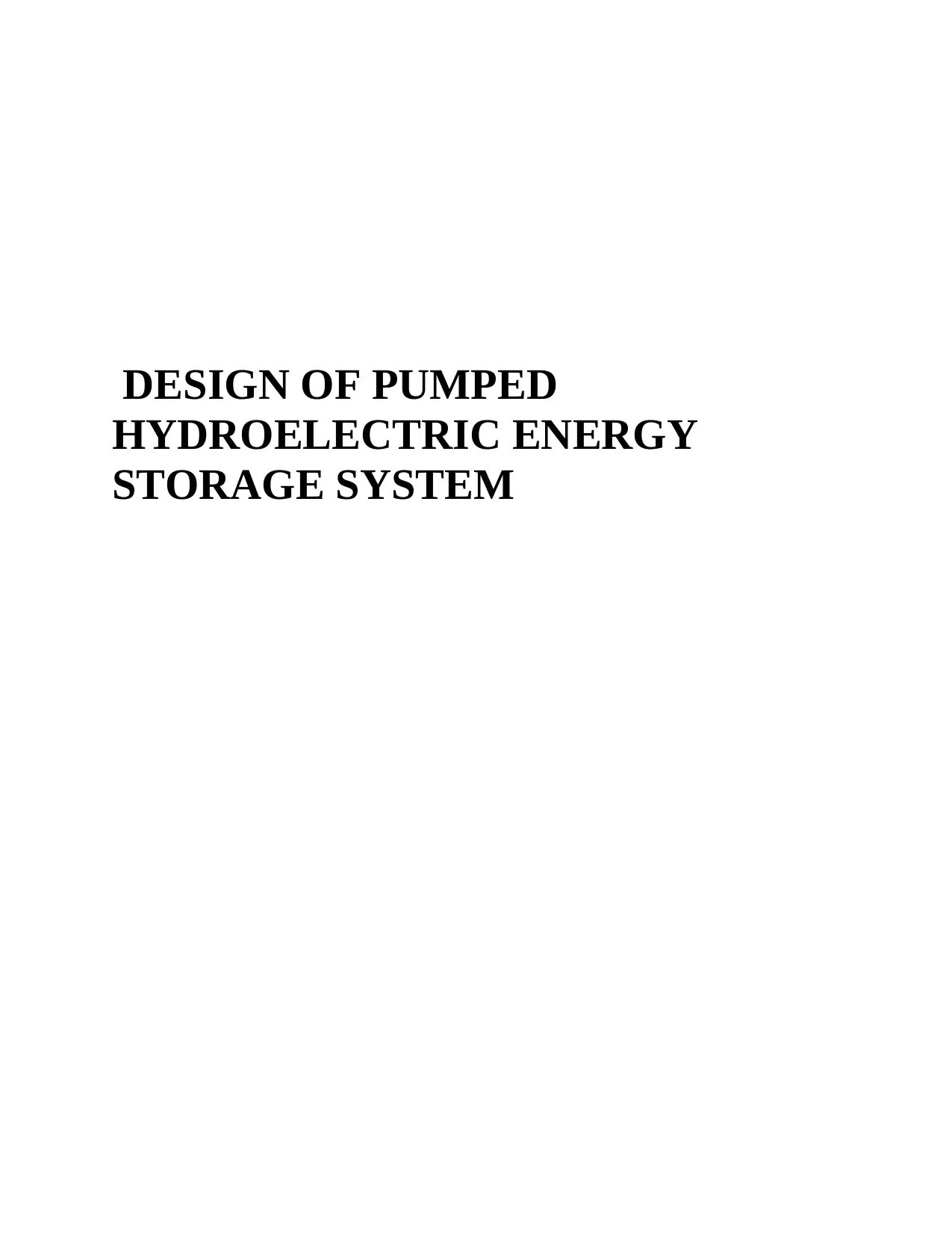
DESIGN OF PUMPED
HYDROELECTRIC ENERGY
STORAGE SYSTEM
HYDROELECTRIC ENERGY
STORAGE SYSTEM
Paraphrase This Document
Need a fresh take? Get an instant paraphrase of this document with our AI Paraphraser
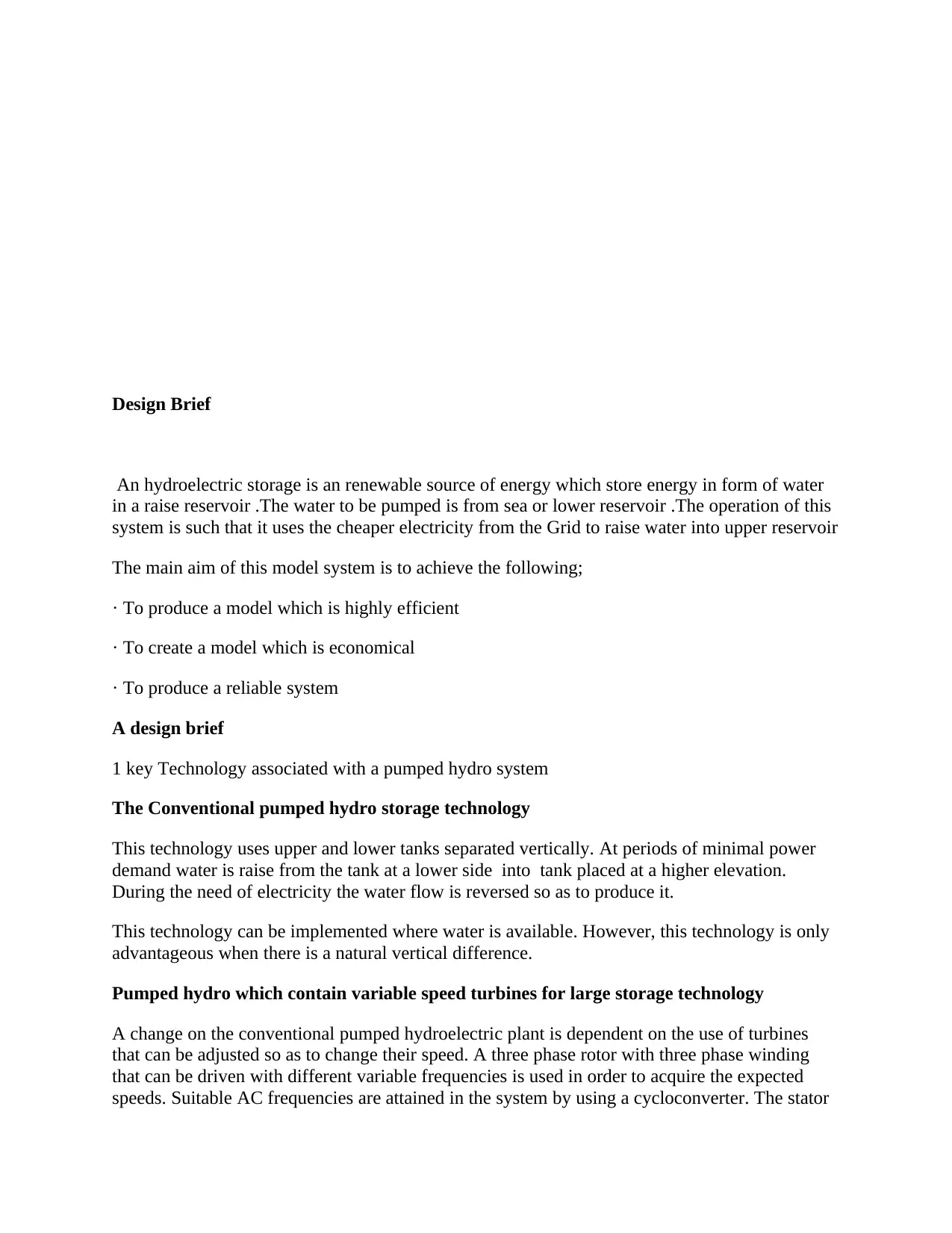
Design Brief
An hydroelectric storage is an renewable source of energy which store energy in form of water
in a raise reservoir .The water to be pumped is from sea or lower reservoir .The operation of this
system is such that it uses the cheaper electricity from the Grid to raise water into upper reservoir
The main aim of this model system is to achieve the following;
· To produce a model which is highly efficient
· To create a model which is economical
· To produce a reliable system
A design brief
1 key Technology associated with a pumped hydro system
The Conventional pumped hydro storage technology
This technology uses upper and lower tanks separated vertically. At periods of minimal power
demand water is raise from the tank at a lower side into tank placed at a higher elevation.
During the need of electricity the water flow is reversed so as to produce it.
This technology can be implemented where water is available. However, this technology is only
advantageous when there is a natural vertical difference.
Pumped hydro which contain variable speed turbines for large storage technology
A change on the conventional pumped hydroelectric plant is dependent on the use of turbines
that can be adjusted so as to change their speed. A three phase rotor with three phase winding
that can be driven with different variable frequencies is used in order to acquire the expected
speeds. Suitable AC frequencies are attained in the system by using a cycloconverter. The stator
An hydroelectric storage is an renewable source of energy which store energy in form of water
in a raise reservoir .The water to be pumped is from sea or lower reservoir .The operation of this
system is such that it uses the cheaper electricity from the Grid to raise water into upper reservoir
The main aim of this model system is to achieve the following;
· To produce a model which is highly efficient
· To create a model which is economical
· To produce a reliable system
A design brief
1 key Technology associated with a pumped hydro system
The Conventional pumped hydro storage technology
This technology uses upper and lower tanks separated vertically. At periods of minimal power
demand water is raise from the tank at a lower side into tank placed at a higher elevation.
During the need of electricity the water flow is reversed so as to produce it.
This technology can be implemented where water is available. However, this technology is only
advantageous when there is a natural vertical difference.
Pumped hydro which contain variable speed turbines for large storage technology
A change on the conventional pumped hydroelectric plant is dependent on the use of turbines
that can be adjusted so as to change their speed. A three phase rotor with three phase winding
that can be driven with different variable frequencies is used in order to acquire the expected
speeds. Suitable AC frequencies are attained in the system by using a cycloconverter. The stator
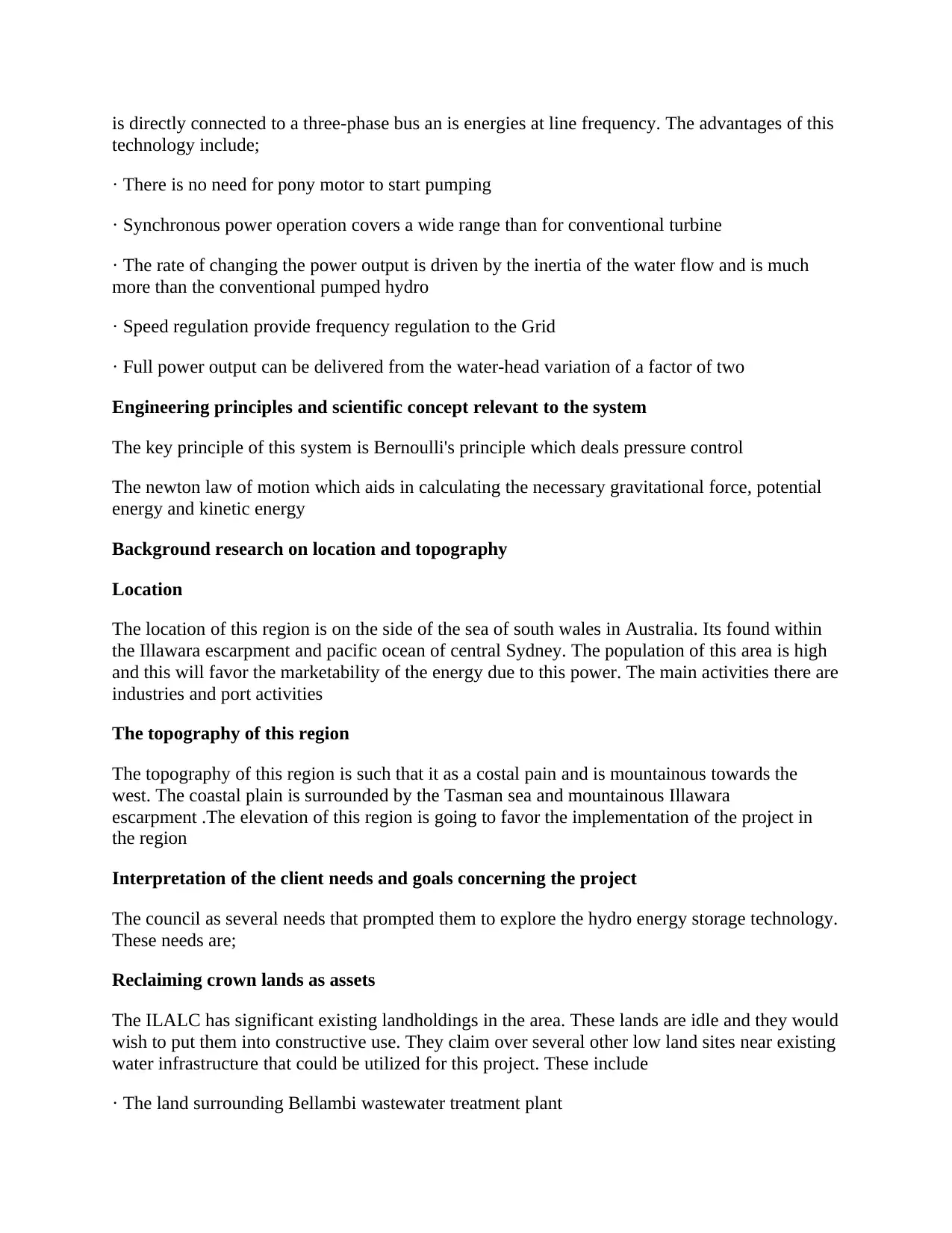
is directly connected to a three-phase bus an is energies at line frequency. The advantages of this
technology include;
· There is no need for pony motor to start pumping
· Synchronous power operation covers a wide range than for conventional turbine
· The rate of changing the power output is driven by the inertia of the water flow and is much
more than the conventional pumped hydro
· Speed regulation provide frequency regulation to the Grid
· Full power output can be delivered from the water-head variation of a factor of two
Engineering principles and scientific concept relevant to the system
The key principle of this system is Bernoulli's principle which deals pressure control
The newton law of motion which aids in calculating the necessary gravitational force, potential
energy and kinetic energy
Background research on location and topography
Location
The location of this region is on the side of the sea of south wales in Australia. Its found within
the Illawara escarpment and pacific ocean of central Sydney. The population of this area is high
and this will favor the marketability of the energy due to this power. The main activities there are
industries and port activities
The topography of this region
The topography of this region is such that it as a costal pain and is mountainous towards the
west. The coastal plain is surrounded by the Tasman sea and mountainous Illawara
escarpment .The elevation of this region is going to favor the implementation of the project in
the region
Interpretation of the client needs and goals concerning the project
The council as several needs that prompted them to explore the hydro energy storage technology.
These needs are;
Reclaiming crown lands as assets
The ILALC has significant existing landholdings in the area. These lands are idle and they would
wish to put them into constructive use. They claim over several other low land sites near existing
water infrastructure that could be utilized for this project. These include
· The land surrounding Bellambi wastewater treatment plant
technology include;
· There is no need for pony motor to start pumping
· Synchronous power operation covers a wide range than for conventional turbine
· The rate of changing the power output is driven by the inertia of the water flow and is much
more than the conventional pumped hydro
· Speed regulation provide frequency regulation to the Grid
· Full power output can be delivered from the water-head variation of a factor of two
Engineering principles and scientific concept relevant to the system
The key principle of this system is Bernoulli's principle which deals pressure control
The newton law of motion which aids in calculating the necessary gravitational force, potential
energy and kinetic energy
Background research on location and topography
Location
The location of this region is on the side of the sea of south wales in Australia. Its found within
the Illawara escarpment and pacific ocean of central Sydney. The population of this area is high
and this will favor the marketability of the energy due to this power. The main activities there are
industries and port activities
The topography of this region
The topography of this region is such that it as a costal pain and is mountainous towards the
west. The coastal plain is surrounded by the Tasman sea and mountainous Illawara
escarpment .The elevation of this region is going to favor the implementation of the project in
the region
Interpretation of the client needs and goals concerning the project
The council as several needs that prompted them to explore the hydro energy storage technology.
These needs are;
Reclaiming crown lands as assets
The ILALC has significant existing landholdings in the area. These lands are idle and they would
wish to put them into constructive use. They claim over several other low land sites near existing
water infrastructure that could be utilized for this project. These include
· The land surrounding Bellambi wastewater treatment plant
⊘ This is a preview!⊘
Do you want full access?
Subscribe today to unlock all pages.

Trusted by 1+ million students worldwide
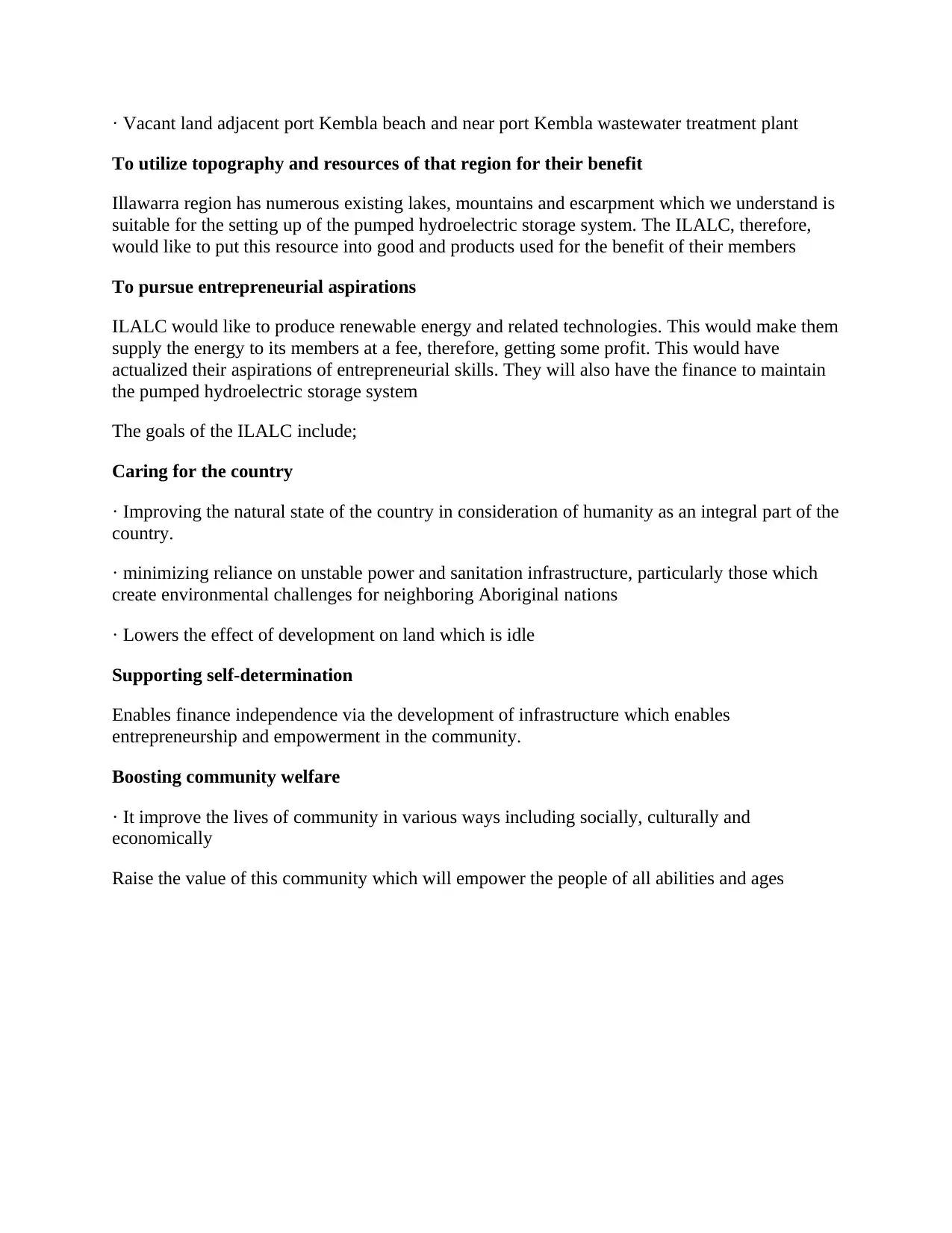
· Vacant land adjacent port Kembla beach and near port Kembla wastewater treatment plant
To utilize topography and resources of that region for their benefit
Illawarra region has numerous existing lakes, mountains and escarpment which we understand is
suitable for the setting up of the pumped hydroelectric storage system. The ILALC, therefore,
would like to put this resource into good and products used for the benefit of their members
To pursue entrepreneurial aspirations
ILALC would like to produce renewable energy and related technologies. This would make them
supply the energy to its members at a fee, therefore, getting some profit. This would have
actualized their aspirations of entrepreneurial skills. They will also have the finance to maintain
the pumped hydroelectric storage system
The goals of the ILALC include;
Caring for the country
· Improving the natural state of the country in consideration of humanity as an integral part of the
country.
· minimizing reliance on unstable power and sanitation infrastructure, particularly those which
create environmental challenges for neighboring Aboriginal nations
· Lowers the effect of development on land which is idle
Supporting self-determination
Enables finance independence via the development of infrastructure which enables
entrepreneurship and empowerment in the community.
Boosting community welfare
· It improve the lives of community in various ways including socially, culturally and
economically
Raise the value of this community which will empower the people of all abilities and ages
To utilize topography and resources of that region for their benefit
Illawarra region has numerous existing lakes, mountains and escarpment which we understand is
suitable for the setting up of the pumped hydroelectric storage system. The ILALC, therefore,
would like to put this resource into good and products used for the benefit of their members
To pursue entrepreneurial aspirations
ILALC would like to produce renewable energy and related technologies. This would make them
supply the energy to its members at a fee, therefore, getting some profit. This would have
actualized their aspirations of entrepreneurial skills. They will also have the finance to maintain
the pumped hydroelectric storage system
The goals of the ILALC include;
Caring for the country
· Improving the natural state of the country in consideration of humanity as an integral part of the
country.
· minimizing reliance on unstable power and sanitation infrastructure, particularly those which
create environmental challenges for neighboring Aboriginal nations
· Lowers the effect of development on land which is idle
Supporting self-determination
Enables finance independence via the development of infrastructure which enables
entrepreneurship and empowerment in the community.
Boosting community welfare
· It improve the lives of community in various ways including socially, culturally and
economically
Raise the value of this community which will empower the people of all abilities and ages
Paraphrase This Document
Need a fresh take? Get an instant paraphrase of this document with our AI Paraphraser
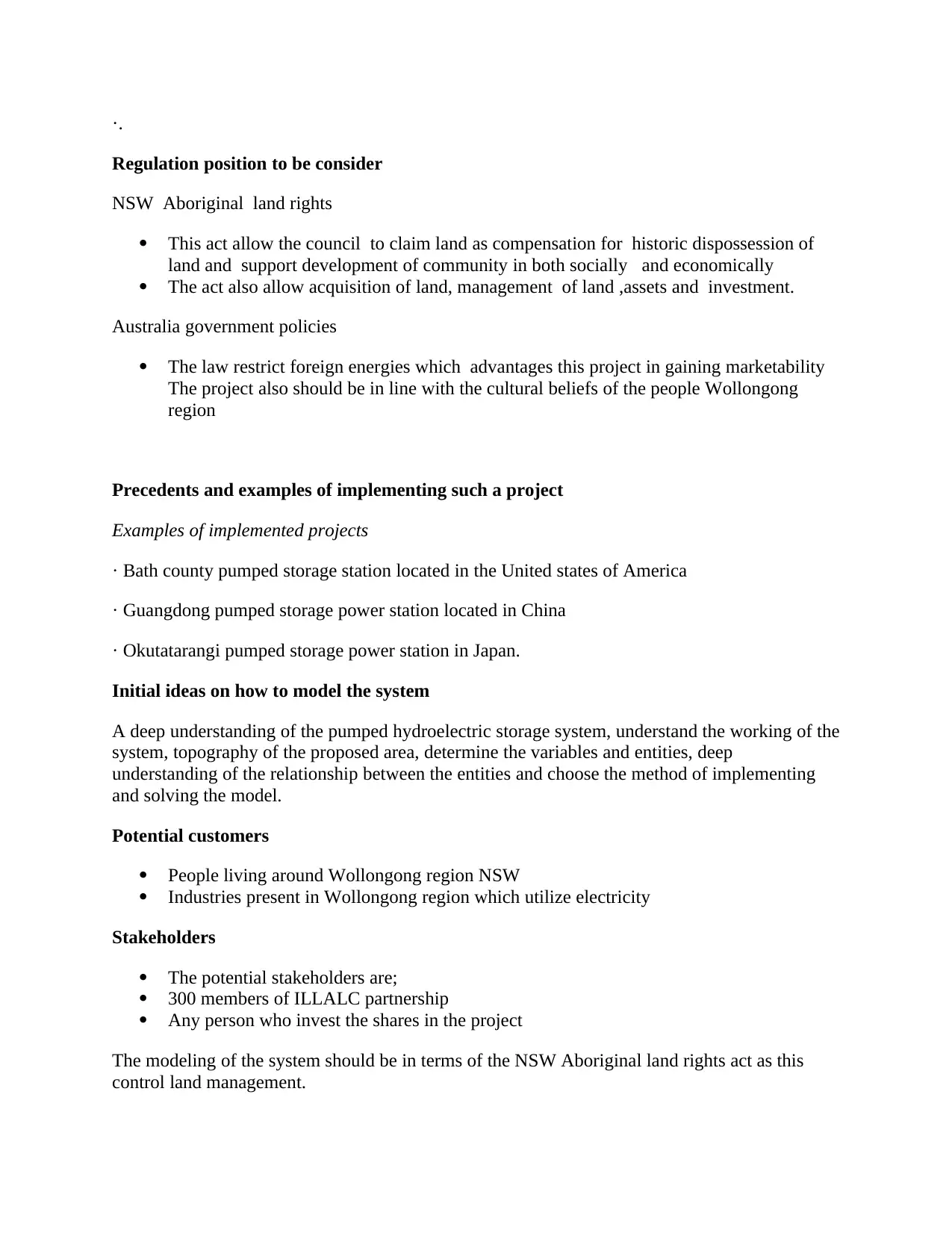
·.
Regulation position to be consider
NSW Aboriginal land rights
This act allow the council to claim land as compensation for historic dispossession of
land and support development of community in both socially and economically
The act also allow acquisition of land, management of land ,assets and investment.
Australia government policies
The law restrict foreign energies which advantages this project in gaining marketability
The project also should be in line with the cultural beliefs of the people Wollongong
region
Precedents and examples of implementing such a project
Examples of implemented projects
· Bath county pumped storage station located in the United states of America
· Guangdong pumped storage power station located in China
· Okutatarangi pumped storage power station in Japan.
Initial ideas on how to model the system
A deep understanding of the pumped hydroelectric storage system, understand the working of the
system, topography of the proposed area, determine the variables and entities, deep
understanding of the relationship between the entities and choose the method of implementing
and solving the model.
Potential customers
People living around Wollongong region NSW
Industries present in Wollongong region which utilize electricity
Stakeholders
The potential stakeholders are;
300 members of ILLALC partnership
Any person who invest the shares in the project
The modeling of the system should be in terms of the NSW Aboriginal land rights act as this
control land management.
Regulation position to be consider
NSW Aboriginal land rights
This act allow the council to claim land as compensation for historic dispossession of
land and support development of community in both socially and economically
The act also allow acquisition of land, management of land ,assets and investment.
Australia government policies
The law restrict foreign energies which advantages this project in gaining marketability
The project also should be in line with the cultural beliefs of the people Wollongong
region
Precedents and examples of implementing such a project
Examples of implemented projects
· Bath county pumped storage station located in the United states of America
· Guangdong pumped storage power station located in China
· Okutatarangi pumped storage power station in Japan.
Initial ideas on how to model the system
A deep understanding of the pumped hydroelectric storage system, understand the working of the
system, topography of the proposed area, determine the variables and entities, deep
understanding of the relationship between the entities and choose the method of implementing
and solving the model.
Potential customers
People living around Wollongong region NSW
Industries present in Wollongong region which utilize electricity
Stakeholders
The potential stakeholders are;
300 members of ILLALC partnership
Any person who invest the shares in the project
The modeling of the system should be in terms of the NSW Aboriginal land rights act as this
control land management.
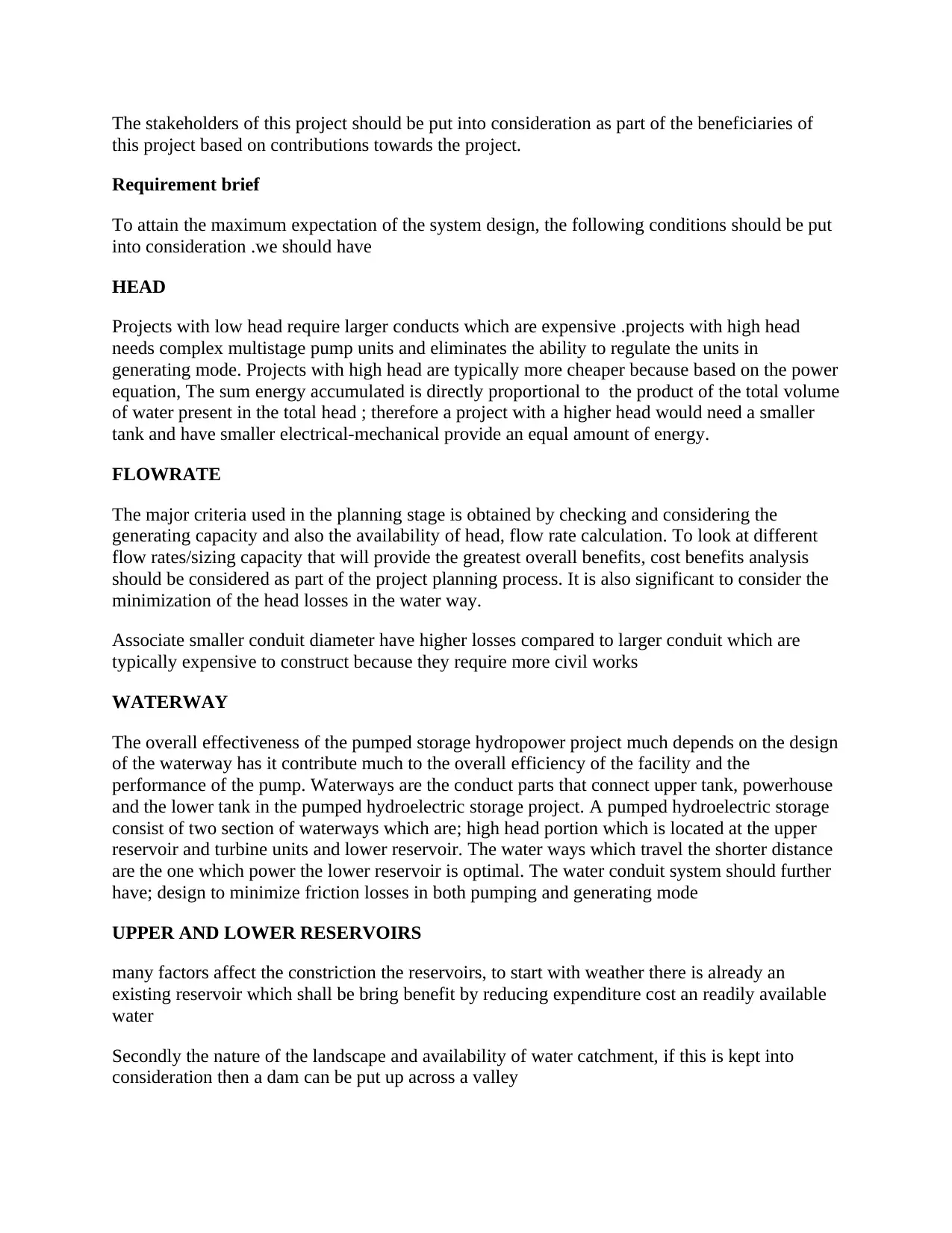
The stakeholders of this project should be put into consideration as part of the beneficiaries of
this project based on contributions towards the project.
Requirement brief
To attain the maximum expectation of the system design, the following conditions should be put
into consideration .we should have
HEAD
Projects with low head require larger conducts which are expensive .projects with high head
needs complex multistage pump units and eliminates the ability to regulate the units in
generating mode. Projects with high head are typically more cheaper because based on the power
equation, The sum energy accumulated is directly proportional to the product of the total volume
of water present in the total head ; therefore a project with a higher head would need a smaller
tank and have smaller electrical-mechanical provide an equal amount of energy.
FLOWRATE
The major criteria used in the planning stage is obtained by checking and considering the
generating capacity and also the availability of head, flow rate calculation. To look at different
flow rates/sizing capacity that will provide the greatest overall benefits, cost benefits analysis
should be considered as part of the project planning process. It is also significant to consider the
minimization of the head losses in the water way.
Associate smaller conduit diameter have higher losses compared to larger conduit which are
typically expensive to construct because they require more civil works
WATERWAY
The overall effectiveness of the pumped storage hydropower project much depends on the design
of the waterway has it contribute much to the overall efficiency of the facility and the
performance of the pump. Waterways are the conduct parts that connect upper tank, powerhouse
and the lower tank in the pumped hydroelectric storage project. A pumped hydroelectric storage
consist of two section of waterways which are; high head portion which is located at the upper
reservoir and turbine units and lower reservoir. The water ways which travel the shorter distance
are the one which power the lower reservoir is optimal. The water conduit system should further
have; design to minimize friction losses in both pumping and generating mode
UPPER AND LOWER RESERVOIRS
many factors affect the constriction the reservoirs, to start with weather there is already an
existing reservoir which shall be bring benefit by reducing expenditure cost an readily available
water
Secondly the nature of the landscape and availability of water catchment, if this is kept into
consideration then a dam can be put up across a valley
this project based on contributions towards the project.
Requirement brief
To attain the maximum expectation of the system design, the following conditions should be put
into consideration .we should have
HEAD
Projects with low head require larger conducts which are expensive .projects with high head
needs complex multistage pump units and eliminates the ability to regulate the units in
generating mode. Projects with high head are typically more cheaper because based on the power
equation, The sum energy accumulated is directly proportional to the product of the total volume
of water present in the total head ; therefore a project with a higher head would need a smaller
tank and have smaller electrical-mechanical provide an equal amount of energy.
FLOWRATE
The major criteria used in the planning stage is obtained by checking and considering the
generating capacity and also the availability of head, flow rate calculation. To look at different
flow rates/sizing capacity that will provide the greatest overall benefits, cost benefits analysis
should be considered as part of the project planning process. It is also significant to consider the
minimization of the head losses in the water way.
Associate smaller conduit diameter have higher losses compared to larger conduit which are
typically expensive to construct because they require more civil works
WATERWAY
The overall effectiveness of the pumped storage hydropower project much depends on the design
of the waterway has it contribute much to the overall efficiency of the facility and the
performance of the pump. Waterways are the conduct parts that connect upper tank, powerhouse
and the lower tank in the pumped hydroelectric storage project. A pumped hydroelectric storage
consist of two section of waterways which are; high head portion which is located at the upper
reservoir and turbine units and lower reservoir. The water ways which travel the shorter distance
are the one which power the lower reservoir is optimal. The water conduit system should further
have; design to minimize friction losses in both pumping and generating mode
UPPER AND LOWER RESERVOIRS
many factors affect the constriction the reservoirs, to start with weather there is already an
existing reservoir which shall be bring benefit by reducing expenditure cost an readily available
water
Secondly the nature of the landscape and availability of water catchment, if this is kept into
consideration then a dam can be put up across a valley
⊘ This is a preview!⊘
Do you want full access?
Subscribe today to unlock all pages.

Trusted by 1+ million students worldwide
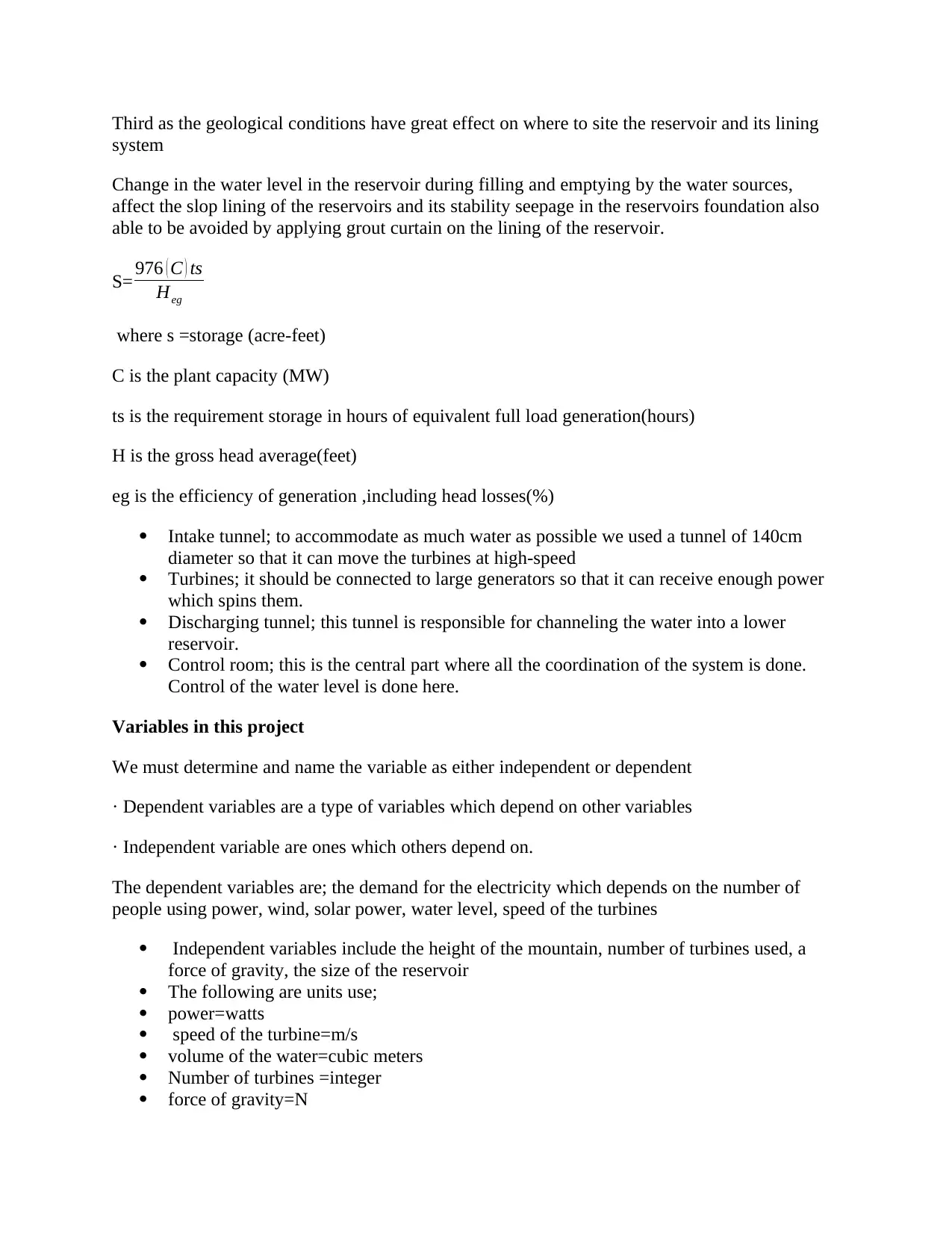
Third as the geological conditions have great effect on where to site the reservoir and its lining
system
Change in the water level in the reservoir during filling and emptying by the water sources,
affect the slop lining of the reservoirs and its stability seepage in the reservoirs foundation also
able to be avoided by applying grout curtain on the lining of the reservoir.
S= 976 ( C ) ts
Heg
where s =storage (acre-feet)
C is the plant capacity (MW)
ts is the requirement storage in hours of equivalent full load generation(hours)
H is the gross head average(feet)
eg is the efficiency of generation ,including head losses(%)
Intake tunnel; to accommodate as much water as possible we used a tunnel of 140cm
diameter so that it can move the turbines at high-speed
Turbines; it should be connected to large generators so that it can receive enough power
which spins them.
Discharging tunnel; this tunnel is responsible for channeling the water into a lower
reservoir.
Control room; this is the central part where all the coordination of the system is done.
Control of the water level is done here.
Variables in this project
We must determine and name the variable as either independent or dependent
· Dependent variables are a type of variables which depend on other variables
· Independent variable are ones which others depend on.
The dependent variables are; the demand for the electricity which depends on the number of
people using power, wind, solar power, water level, speed of the turbines
Independent variables include the height of the mountain, number of turbines used, a
force of gravity, the size of the reservoir
The following are units use;
power=watts
speed of the turbine=m/s
volume of the water=cubic meters
Number of turbines =integer
force of gravity=N
system
Change in the water level in the reservoir during filling and emptying by the water sources,
affect the slop lining of the reservoirs and its stability seepage in the reservoirs foundation also
able to be avoided by applying grout curtain on the lining of the reservoir.
S= 976 ( C ) ts
Heg
where s =storage (acre-feet)
C is the plant capacity (MW)
ts is the requirement storage in hours of equivalent full load generation(hours)
H is the gross head average(feet)
eg is the efficiency of generation ,including head losses(%)
Intake tunnel; to accommodate as much water as possible we used a tunnel of 140cm
diameter so that it can move the turbines at high-speed
Turbines; it should be connected to large generators so that it can receive enough power
which spins them.
Discharging tunnel; this tunnel is responsible for channeling the water into a lower
reservoir.
Control room; this is the central part where all the coordination of the system is done.
Control of the water level is done here.
Variables in this project
We must determine and name the variable as either independent or dependent
· Dependent variables are a type of variables which depend on other variables
· Independent variable are ones which others depend on.
The dependent variables are; the demand for the electricity which depends on the number of
people using power, wind, solar power, water level, speed of the turbines
Independent variables include the height of the mountain, number of turbines used, a
force of gravity, the size of the reservoir
The following are units use;
power=watts
speed of the turbine=m/s
volume of the water=cubic meters
Number of turbines =integer
force of gravity=N
Paraphrase This Document
Need a fresh take? Get an instant paraphrase of this document with our AI Paraphraser
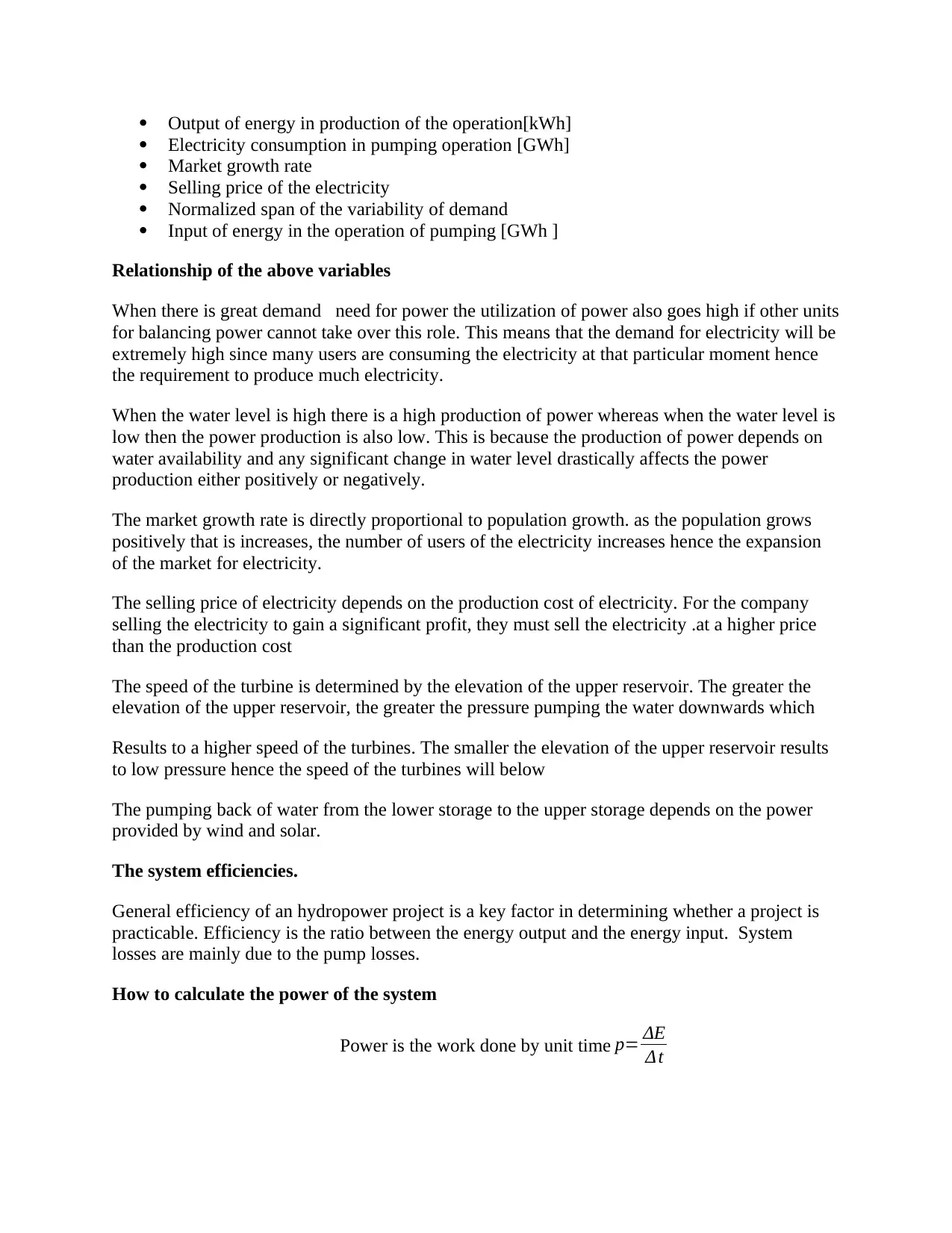
Output of energy in production of the operation[kWh]
Electricity consumption in pumping operation [GWh]
Market growth rate
Selling price of the electricity
Normalized span of the variability of demand
Input of energy in the operation of pumping [GWh ]
Relationship of the above variables
When there is great demand need for power the utilization of power also goes high if other units
for balancing power cannot take over this role. This means that the demand for electricity will be
extremely high since many users are consuming the electricity at that particular moment hence
the requirement to produce much electricity.
When the water level is high there is a high production of power whereas when the water level is
low then the power production is also low. This is because the production of power depends on
water availability and any significant change in water level drastically affects the power
production either positively or negatively.
The market growth rate is directly proportional to population growth. as the population grows
positively that is increases, the number of users of the electricity increases hence the expansion
of the market for electricity.
The selling price of electricity depends on the production cost of electricity. For the company
selling the electricity to gain a significant profit, they must sell the electricity .at a higher price
than the production cost
The speed of the turbine is determined by the elevation of the upper reservoir. The greater the
elevation of the upper reservoir, the greater the pressure pumping the water downwards which
Results to a higher speed of the turbines. The smaller the elevation of the upper reservoir results
to low pressure hence the speed of the turbines will below
The pumping back of water from the lower storage to the upper storage depends on the power
provided by wind and solar.
The system efficiencies.
General efficiency of an hydropower project is a key factor in determining whether a project is
practicable. Efficiency is the ratio between the energy output and the energy input. System
losses are mainly due to the pump losses.
How to calculate the power of the system
Power is the work done by unit time p= ΔE
Δ t
Electricity consumption in pumping operation [GWh]
Market growth rate
Selling price of the electricity
Normalized span of the variability of demand
Input of energy in the operation of pumping [GWh ]
Relationship of the above variables
When there is great demand need for power the utilization of power also goes high if other units
for balancing power cannot take over this role. This means that the demand for electricity will be
extremely high since many users are consuming the electricity at that particular moment hence
the requirement to produce much electricity.
When the water level is high there is a high production of power whereas when the water level is
low then the power production is also low. This is because the production of power depends on
water availability and any significant change in water level drastically affects the power
production either positively or negatively.
The market growth rate is directly proportional to population growth. as the population grows
positively that is increases, the number of users of the electricity increases hence the expansion
of the market for electricity.
The selling price of electricity depends on the production cost of electricity. For the company
selling the electricity to gain a significant profit, they must sell the electricity .at a higher price
than the production cost
The speed of the turbine is determined by the elevation of the upper reservoir. The greater the
elevation of the upper reservoir, the greater the pressure pumping the water downwards which
Results to a higher speed of the turbines. The smaller the elevation of the upper reservoir results
to low pressure hence the speed of the turbines will below
The pumping back of water from the lower storage to the upper storage depends on the power
provided by wind and solar.
The system efficiencies.
General efficiency of an hydropower project is a key factor in determining whether a project is
practicable. Efficiency is the ratio between the energy output and the energy input. System
losses are mainly due to the pump losses.
How to calculate the power of the system
Power is the work done by unit time p= ΔE
Δ t
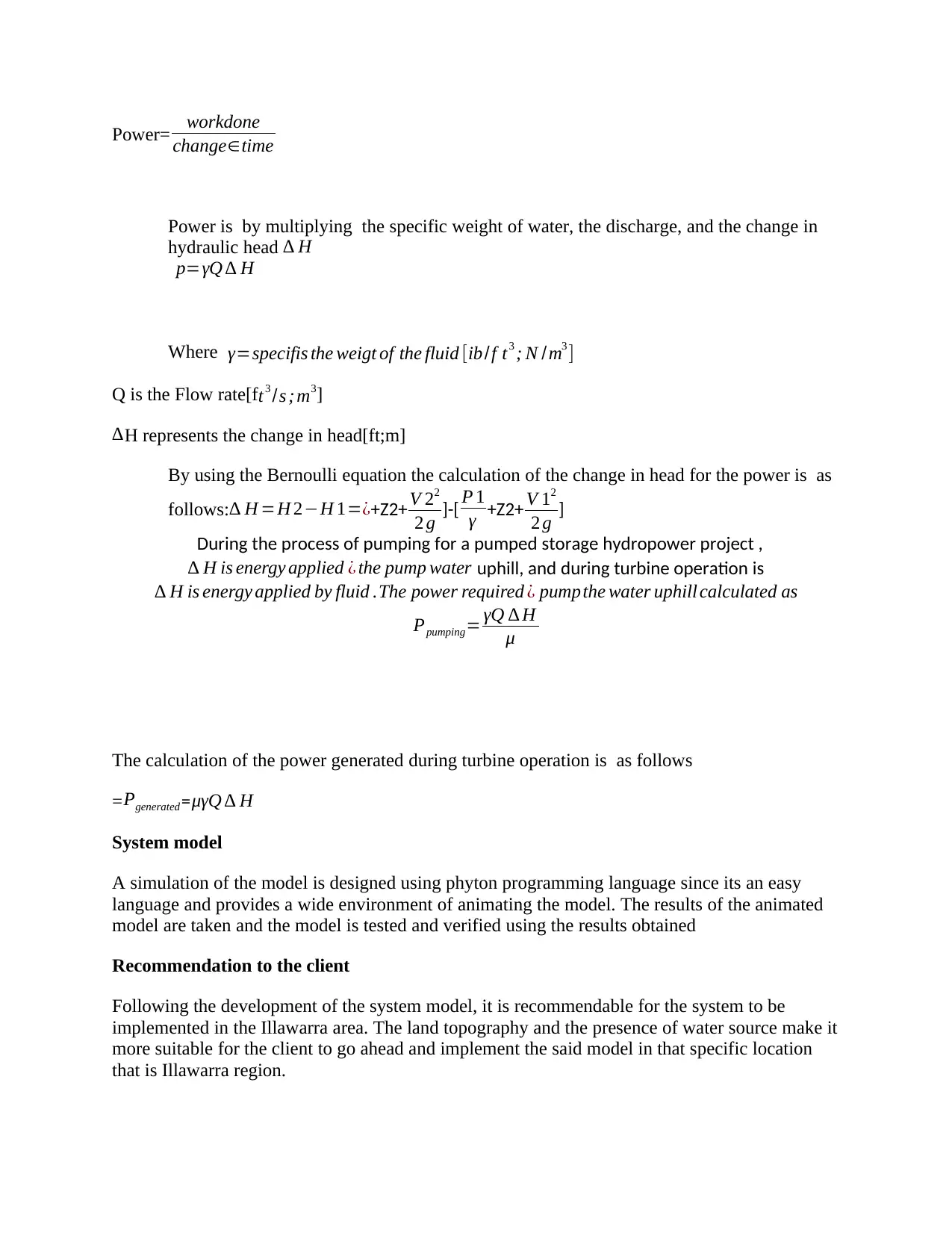
Power= workdone
change∈time
Power is by multiplying the specific weight of water, the discharge, and the change in
hydraulic head ∆ H
p=γQ ∆ H
Where γ=specifis the weigt of the fluid [ib/f t3 ; N /m3 ]
Q is the Flow rate[ft3 /s ;m3]
∆H represents the change in head[ft;m]
By using the Bernoulli equation the calculation of the change in head for the power is as
follows: ∆ H =H 2−H 1=¿+Z2+ V 22
2 g ]-[ P 1
γ +Z2+ V 12
2 g ]
During the process of pumping for a pumped storage hydropower project ,
∆ H is energy applied ¿ the pump water uphill, and during turbine operation is
∆ H is energy applied by fluid .The power required ¿ pump the water uphill calculated as
Ppumping= γQ ∆ H
μ
The calculation of the power generated during turbine operation is as follows
=Pgenerated =μγQ ∆ H
System model
A simulation of the model is designed using phyton programming language since its an easy
language and provides a wide environment of animating the model. The results of the animated
model are taken and the model is tested and verified using the results obtained
Recommendation to the client
Following the development of the system model, it is recommendable for the system to be
implemented in the Illawarra area. The land topography and the presence of water source make it
more suitable for the client to go ahead and implement the said model in that specific location
that is Illawarra region.
change∈time
Power is by multiplying the specific weight of water, the discharge, and the change in
hydraulic head ∆ H
p=γQ ∆ H
Where γ=specifis the weigt of the fluid [ib/f t3 ; N /m3 ]
Q is the Flow rate[ft3 /s ;m3]
∆H represents the change in head[ft;m]
By using the Bernoulli equation the calculation of the change in head for the power is as
follows: ∆ H =H 2−H 1=¿+Z2+ V 22
2 g ]-[ P 1
γ +Z2+ V 12
2 g ]
During the process of pumping for a pumped storage hydropower project ,
∆ H is energy applied ¿ the pump water uphill, and during turbine operation is
∆ H is energy applied by fluid .The power required ¿ pump the water uphill calculated as
Ppumping= γQ ∆ H
μ
The calculation of the power generated during turbine operation is as follows
=Pgenerated =μγQ ∆ H
System model
A simulation of the model is designed using phyton programming language since its an easy
language and provides a wide environment of animating the model. The results of the animated
model are taken and the model is tested and verified using the results obtained
Recommendation to the client
Following the development of the system model, it is recommendable for the system to be
implemented in the Illawarra area. The land topography and the presence of water source make it
more suitable for the client to go ahead and implement the said model in that specific location
that is Illawarra region.
⊘ This is a preview!⊘
Do you want full access?
Subscribe today to unlock all pages.

Trusted by 1+ million students worldwide
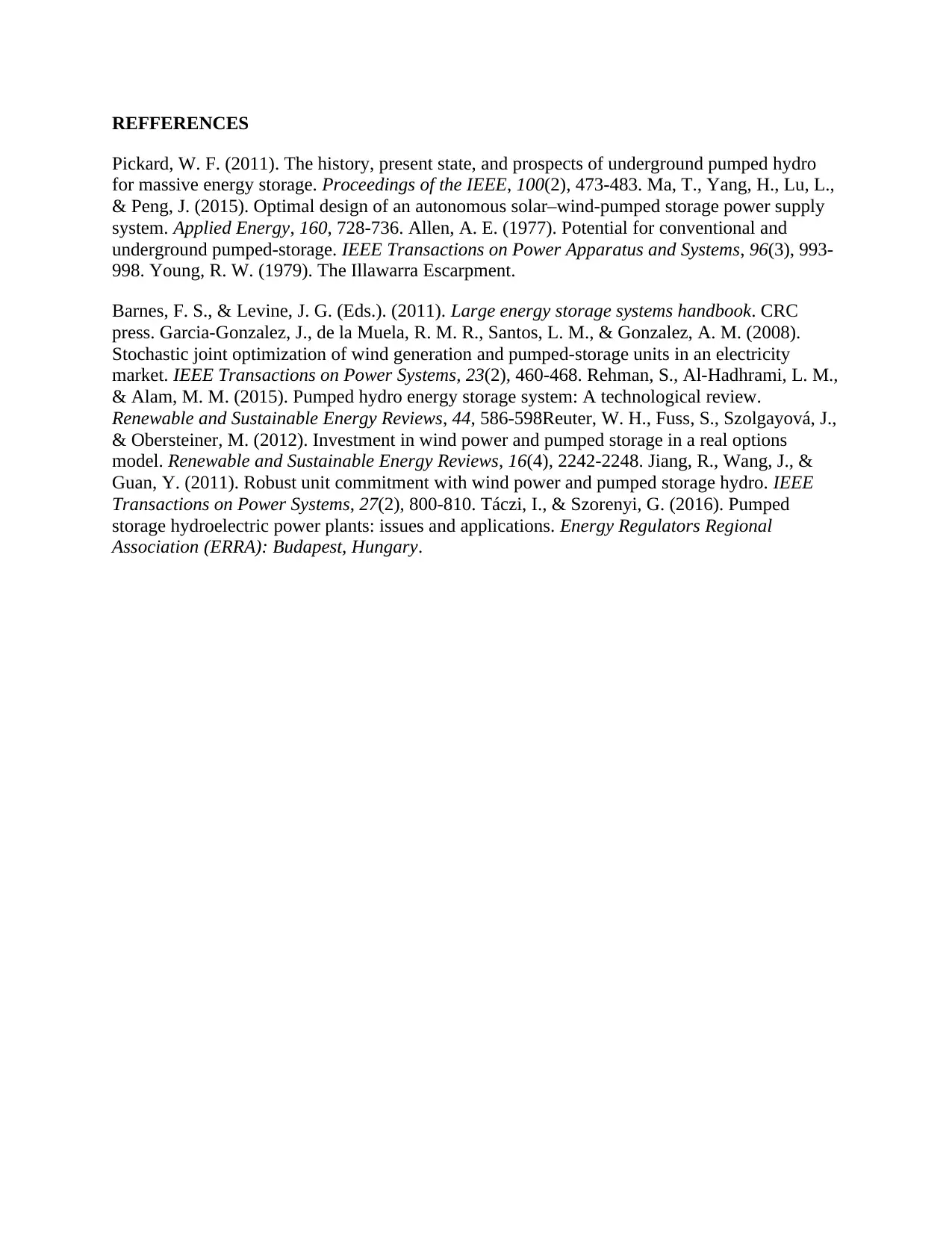
REFFERENCES
Pickard, W. F. (2011). The history, present state, and prospects of underground pumped hydro
for massive energy storage. Proceedings of the IEEE, 100(2), 473-483. Ma, T., Yang, H., Lu, L.,
& Peng, J. (2015). Optimal design of an autonomous solar–wind-pumped storage power supply
system. Applied Energy, 160, 728-736. Allen, A. E. (1977). Potential for conventional and
underground pumped-storage. IEEE Transactions on Power Apparatus and Systems, 96(3), 993-
998. Young, R. W. (1979). The Illawarra Escarpment.
Barnes, F. S., & Levine, J. G. (Eds.). (2011). Large energy storage systems handbook. CRC
press. Garcia-Gonzalez, J., de la Muela, R. M. R., Santos, L. M., & Gonzalez, A. M. (2008).
Stochastic joint optimization of wind generation and pumped-storage units in an electricity
market. IEEE Transactions on Power Systems, 23(2), 460-468. Rehman, S., Al-Hadhrami, L. M.,
& Alam, M. M. (2015). Pumped hydro energy storage system: A technological review.
Renewable and Sustainable Energy Reviews, 44, 586-598Reuter, W. H., Fuss, S., Szolgayová, J.,
& Obersteiner, M. (2012). Investment in wind power and pumped storage in a real options
model. Renewable and Sustainable Energy Reviews, 16(4), 2242-2248. Jiang, R., Wang, J., &
Guan, Y. (2011). Robust unit commitment with wind power and pumped storage hydro. IEEE
Transactions on Power Systems, 27(2), 800-810. Táczi, I., & Szorenyi, G. (2016). Pumped
storage hydroelectric power plants: issues and applications. Energy Regulators Regional
Association (ERRA): Budapest, Hungary.
Pickard, W. F. (2011). The history, present state, and prospects of underground pumped hydro
for massive energy storage. Proceedings of the IEEE, 100(2), 473-483. Ma, T., Yang, H., Lu, L.,
& Peng, J. (2015). Optimal design of an autonomous solar–wind-pumped storage power supply
system. Applied Energy, 160, 728-736. Allen, A. E. (1977). Potential for conventional and
underground pumped-storage. IEEE Transactions on Power Apparatus and Systems, 96(3), 993-
998. Young, R. W. (1979). The Illawarra Escarpment.
Barnes, F. S., & Levine, J. G. (Eds.). (2011). Large energy storage systems handbook. CRC
press. Garcia-Gonzalez, J., de la Muela, R. M. R., Santos, L. M., & Gonzalez, A. M. (2008).
Stochastic joint optimization of wind generation and pumped-storage units in an electricity
market. IEEE Transactions on Power Systems, 23(2), 460-468. Rehman, S., Al-Hadhrami, L. M.,
& Alam, M. M. (2015). Pumped hydro energy storage system: A technological review.
Renewable and Sustainable Energy Reviews, 44, 586-598Reuter, W. H., Fuss, S., Szolgayová, J.,
& Obersteiner, M. (2012). Investment in wind power and pumped storage in a real options
model. Renewable and Sustainable Energy Reviews, 16(4), 2242-2248. Jiang, R., Wang, J., &
Guan, Y. (2011). Robust unit commitment with wind power and pumped storage hydro. IEEE
Transactions on Power Systems, 27(2), 800-810. Táczi, I., & Szorenyi, G. (2016). Pumped
storage hydroelectric power plants: issues and applications. Energy Regulators Regional
Association (ERRA): Budapest, Hungary.
1 out of 10
Your All-in-One AI-Powered Toolkit for Academic Success.
+13062052269
info@desklib.com
Available 24*7 on WhatsApp / Email
![[object Object]](/_next/static/media/star-bottom.7253800d.svg)
Unlock your academic potential
Copyright © 2020–2025 A2Z Services. All Rights Reserved. Developed and managed by ZUCOL.

